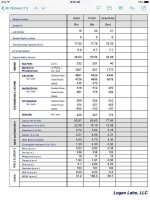on the other hand
on the other hand
So I am looking at a mix that is 40% peat and compost and 20% lava rock. Tested with no amendments:
tcec...29.2
pH.....7.0
organic matter...30.91
sulfur...167 ppm
P2O5...1183 ppm (a life time supply, no evil soft rock for me)
base cation saturations:
Ca...62.19% (678 lbs per acre short)
Mg...13.96
K...15.84 (this is an issue, 4 x the ppm I would ideally like to see)
Na...3.6 (I got something for this, spectrum extra to the rescue, but more K, doh)
H...0
micros
B...1.05
Fe...162
Mn...20
Cu...1.62
Zn...13.32
Al....41
So I need some gypsum (the Ca will drive the Mg off the cec sites and pH will go down/H will go up...or I could use a little AS if I need N). I need a fair amount of Mn and a little B and Cu.
Definitely foliar Zn and Mn.
But overall not bad and 30% organic matter to buffer...hell yea. Gonna be a great year.
on the other hand
So I am looking at a mix that is 40% peat and compost and 20% lava rock. Tested with no amendments:
tcec...29.2
pH.....7.0
organic matter...30.91
sulfur...167 ppm
P2O5...1183 ppm (a life time supply, no evil soft rock for me)
base cation saturations:
Ca...62.19% (678 lbs per acre short)
Mg...13.96
K...15.84 (this is an issue, 4 x the ppm I would ideally like to see)
Na...3.6 (I got something for this, spectrum extra to the rescue, but more K, doh)
H...0
micros
B...1.05
Fe...162
Mn...20
Cu...1.62
Zn...13.32
Al....41
So I need some gypsum (the Ca will drive the Mg off the cec sites and pH will go down/H will go up...or I could use a little AS if I need N). I need a fair amount of Mn and a little B and Cu.
Definitely foliar Zn and Mn.
But overall not bad and 30% organic matter to buffer...hell yea. Gonna be a great year.




